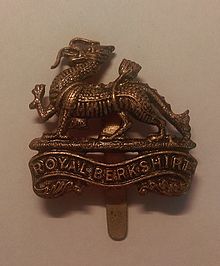The Royal Berkshire Regiment (Princess Charlotte of Wales's)
| Princess Charlotte of Wales's (Royal Berkshire Regiment) Royal Berkshire Regiment (Princess Charlotte of Wales's) |
|
|---|---|

Cap badge of the Royal Berkshire Regiment.
|
|
| Active | 1881–1959 |
| Country |
|
| Branch |
|
| Type | Infantry |
| Role | Line infantry |
| Size | 2 Regular battalions 1 Militia battalion (Royal Berkshire Regiment of Militia) 1 – 2 Territorial and Volunteer battalions Up to 12 hostilities-only battalions |
| Garrison/HQ | Brock Barracks, Reading |
| Nickname(s) | "The Biscuit Boys" |
| Anniversaries | Maiwand (27 July) |
| Engagements |
Second Boer War World War I World War II |
The Royal Berkshire Regiment (Princess Charlotte of Wales's) was a line infantry regiment of the British Army in existence from 1881 until 1959. The regiment was created in 1881, as the Princess Charlotte of Wales's (Royal Berkshire Regiment), by the amalgamation of the 49th (Princess Charlotte of Wales's) (Hertfordshire) Regiment of Foot and the 66th (Berkshire) Regiment of Foot. In 1921, it was renamed the Royal Berkshire Regiment (Princess Charlotte of Wales's).
The regiment saw active service in the Second Boer War, World War I and World War II. On 9 June 1959, the Royal Berkshire Regiment (Princess Charlotte of Wales's) was amalgamated with the Wiltshire Regiment (Duke of Edinburgh's) to form the Duke of Edinburgh's Royal Regiment (Berkshire and Wiltshire) which was again amalgamated, on 27 July 1994, with the Gloucestershire Regiment to create the Royal Gloucestershire, Berkshire and Wiltshire Regiment. Like its predecessor regiment, however, this was on 1 February 2007, merged with the Devonshire and Dorset Regiment, the Royal Green Jackets and The Light Infantry to form a new large regiment, The Rifles.
The Berkshire Regiment was formed as part of the reforms carried out by Edward Cardwell and Hugh Childers, Secretaries of State for War in the late nineteenth century. The first stage, under Cardwell in 1873, introduced a "localisation scheme". This saw the United Kingdom divided into "Brigade Districts" consisting of a county or counties. Each district was assigned two regular infantry battalions, one of which would be on foreign service while the other was on home service. The home-based battalion was to provide drafts to the battalion on foreign duty as required. County militia regiments were also to be linked with the regular battalions, with all sharing a single depot in the brigade district. It was announced that a depot was to be built at Reading, Berkshire, which would serve a district comprising the County of Berkshire. The two line battalions which were to be linked were the 49th and 66th Regiments of Foot, along with the Berkshire Militia. On 1 July 1881, the reforms were completed under Childers, with the formation of the The Princess Charlotte of Wales's (Berkshire Regiment)
...
Wikipedia
